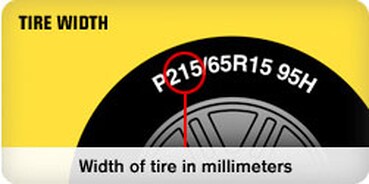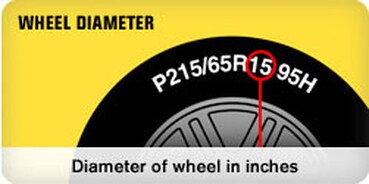With a little explanation it’s easy to understand what all of the letters and numbers mean on your tire’s sidewall. The numbers are indicators of the size, type, and performance of the tire.

The letter “P” at the beginning of the “Tire Size” tells us the tire is a P-Metric tire, referring to tires made to certain standards within the United States, intended for Passenger vehicles.
If a tire size has no letters at the beginning, this indicates a Euro metric tire. P-Metric and Euro-Metric tires may have different load capacities.
The letters “LT,” either at the beginning or at the end of the tire size indicate the tire was designed for light trucks. Vehicle manufacturers equip some light trucks with “LT” type tires. These tires generally require higher inflation pressures than passenger tires.
Consult your owner’s manual or tire placard for the recommended tire size and inflation pressure for your vehicle.

Is the width of the tire measured in millimeters from sidewall to sidewall. The first three-digit number in the tire size refers to the tire width. For instance, in a size P215/65 R15 tire, the width is 215 millimeters.

Is the ratio of the height of the tire’s cross-section to its width. The two-digit number after the slash mark in a tire size is the aspect ratio. For example, in a size P215/65 R15 tire, the 65 means that the height is equal to 65% of the tire’s width. The bigger the aspect ratio, the bigger the tire’s sidewall will be.

The letter “R” in a tire size stands for Radial, which means the layers run radially across the tire.

Is the size of the wheel measured from one end to the other. It tells us the size of the wheel that the tire is intended to fit. A size P215/65 R15 tire is made for a wheel with a 15″ diameter.
Indicates the maximum load that the tyre can support when properly inflated. You’ll also find the maximum load on the tyre sidewall, in both pounds and kilograms. Learn more about tyre load index.
Tells you the maximum speed capability of a tire. Often speed ratings are matched to the top speed capability of the vehicle. For example, a tire with an H-speed rating has a maximum speed capability of 130 mph or 210 km/h. Goodyear does NOT recommend exceeding legally posted speed limits. Learn more about tire speed rating.
The letters “DOT” on the sidewall indicate that the tire complies with all applicable Federal Motor Vehicle Safety Standards in the United States.
The series of letters and numbers following the letters “DOT.” The TIN consists of up to 12 numbers and letters to identify the factory location and the week and year the tire was manufactured.
Stands for Uniform Tire Quality Grading, a rating system developed by the U.S. Department of Transportation to provide consumers with information to help them purchase tires based on their relative treadwear, traction and temperature capabilities.
Traction grades indicate the wet traction of a tire under a controlled test. A tire with an “AA” rating offers outstanding traction in wet conditions.
Traction Grades
Temperature grades indicate the ability of the tire to withstand and dissipate destructive heat. A tire with a higher temperature grade is able to operate at higher speeds.
|
Temperature Grades
|
Speeds in mph
|
|---|---|
|
A
|
Over 115
|
|
B
|
Between 100 and 115
|
|
C
|
Between 85 and 100
|
Treadwear grades are based on standardized government tests to help predict the expected treadwear of a tire. For example, a tire with a treadwear grade of 200 should last twice as long as a tire with a treadwear grade of 100.

What is Wheel Alignment? Wheel alignment involves a mechanical adjustment of vehicle suspension to influence the direction and angle of the tyre’s contact with the road surface. The optimum alignment for each make and model of vehicle is set by the manufacturer in order to influence the performance and handling. Alignment also impacts upon safety […]
© All Rights Reserved
Made With ❤️ by Core Coding Company